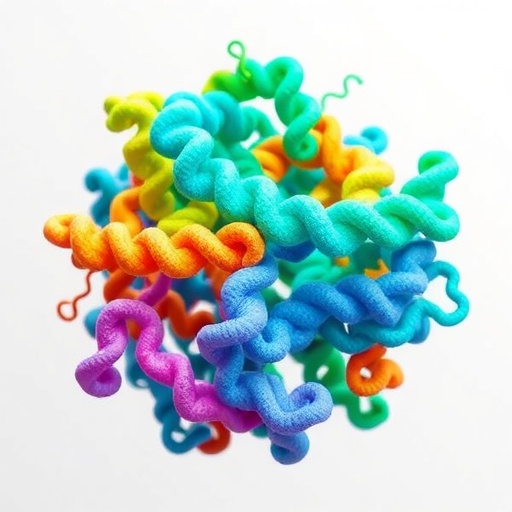In a groundbreaking study that advances our understanding of protein biophysics and misfolding phenomena, researchers at Penn State have utilized cutting-edge all-atom computer simulations to identify and characterize a novel class of protein misfolding known as non-native entanglement. This structural anomaly manifests when specific segments of a protein’s amino acid chain become inappropriately looped or threaded, disrupting the protein’s native three-dimensional conformation. Such misfolding events are of paramount interest because they can hinder proper protein function and are implicated in numerous diseases, including neurodegenerative disorders like Alzheimer’s and Parkinson’s.
Proteins are complex macromolecules composed of linear sequences of amino acids, which inherently possess the ability to fold spontaneously into precise three-dimensional structures, termed the native state. This native conformation is crucial for their biological activity. Folding errors, or misfolds, can result in a variety of dysfunctional states, some of which expose hydrophobic regions or form aberrant structural motifs, thereby compromising cellular health. The concept of non-native entanglements adds a new dimension to this landscape by highlighting scenarios where topological constraints—reminiscent of loops and knots—materialize erroneously, effectively altering the protein’s folding trajectory and stability.
Historically, protein folding simulations have relied predominantly on coarse-grained models that abstract away atomic details to simplify and accelerate computation. While these models have revealed important insights, questions arose regarding their capacity to capture intricate chemical and physical interactions inherent at the atomic level. Addressing this, the Penn State team employed all-atom molecular dynamics simulations, which model each atom of the protein with high resolution, thereby capturing the nuanced interplay of intra-molecular forces, hydrogen bonding, van der Waals interactions, and steric hindrance essential for accurate folding predictions.
Their simulations focused on small, well-studied proteins such as Ubiquitin and λ-repressor, which serve as canonical models in folding studies. The data showed that these proteins can indeed adopt non-native entangled conformations during folding, corroborating previous findings from coarser simulations. However, the all-atom approach revealed a critical distinction: in smaller proteins, these entanglement misfolds tend to be transient, resolving relatively quickly as the protein chain rearranges and corrects the topology. This temporal dynamic differs markedly from that observed in larger, more complex proteins where non-native entanglements can persist for extended periods.
Dr. Ed O’Brien, the principal investigator, explained that the persistence of non-native entanglements in larger proteins likely arises because rectifying these misfolds requires a substantial backtracking of the folding process, involving unfolding and refolding of multiple structural elements. Moreover, these entangled states may be deeply buried within the protein’s core, effectively shielding them from cellular quality control systems designed to detect and mitigate misfolded proteins. This cloaking enables their prolonged existence in vivo, with the potential to impair cellular function or promote pathological aggregation.
Further strengthening their computational findings, the team utilized experimental methods, including mass spectrometry, to track folding intermediates and structural ensembles of the proteins under study. Although direct observation of non-native entanglements remains technically challenging due to their transient and subtle nature, the experimental data demonstrated structural changes consistent with the predicted entangled misfolds. This convergence of simulation and experiment underscores the biological relevance and validity of the all-atom simulation approach.
The discovery of non-native entanglement as a distinct mode of protein misfolding opens new research avenues exploring how these topological errors emerge and persist within the cellular environment. These insights may prove transformative for understanding the molecular etiology of protein aggregation diseases. Researchers hypothesize that targeting the molecular machinery or pathways that recognize, prevent, or resolve entangled misfolds could yield novel therapeutic strategies to combat age-related neurodegeneration and other protein misfolding disorders.
Significantly, the research also clarifies the limitations of existing protein quality control systems, which appear to be less adept at detecting topological misfolds compared to more conventional misfolded protein structures. This blind spot may contribute to the accumulation of dysfunctional proteins and cellular stress over time, linking non-native entanglements to the biological processes underlying aging.
Another compelling facet of this study is the demonstration of how advanced computational methods, including high-resolution simulations on supercomputing platforms like the Roar supercomputer at Penn State, can illuminate complex molecular phenomena that are experimentally elusive. This synergy between computation and experiment exemplifies the future trajectory of molecular biology, enabling the dissection of protein dynamics at scales and resolutions previously unattainable.
The research team includes chemists, computational scientists, and statisticians, reflecting the interdisciplinary nature necessary to tackle such intricate biological questions. Their collaboration spans institutions in the United States and Europe, emphasizing the global effort dedicated to deciphering protein folding mechanisms.
Ultimately, this study provides a compelling narrative that challenges traditional paradigms of protein folding and misfolding by emphasizing the role of topological features such as non-native entanglements. As these insights mature, they hold promise not only for fundamental biochemistry but also for drug discovery efforts aimed at stabilizing protein structures or enhancing cellular clearance of misfolded species.
This work, published in the prestigious journal Science Advances, represents a significant leap forward in protein science, spotlighting the nuanced choreography of folding and the hidden complexities that can derail it. Continued exploration of non-native entanglements will undoubtedly reveal further intricacies of protein biology, fostering new hope for tackling diseases rooted in protein misfolding and aggregation.
Subject of Research: Not applicable
Article Title: Non-native entanglement protein misfolding observed in all-atom simulations and supported by experimental structural ensembles
News Publication Date: 8-Aug-2025
Web References: http://dx.doi.org/10.1126/sciadv.adt8974
References: O’Brien Laboratory, Penn State; Science Advances, 8 August 2025
Image Credits: O’Brien Laboratory, Penn State
Keywords
protein folding, protein misfolding, non-native entanglement, all-atom simulation, molecular dynamics, protein topology, neurodegenerative disease, Ubiquitin, λ-repressor, computational biology, protein quality control, mass spectrometry




